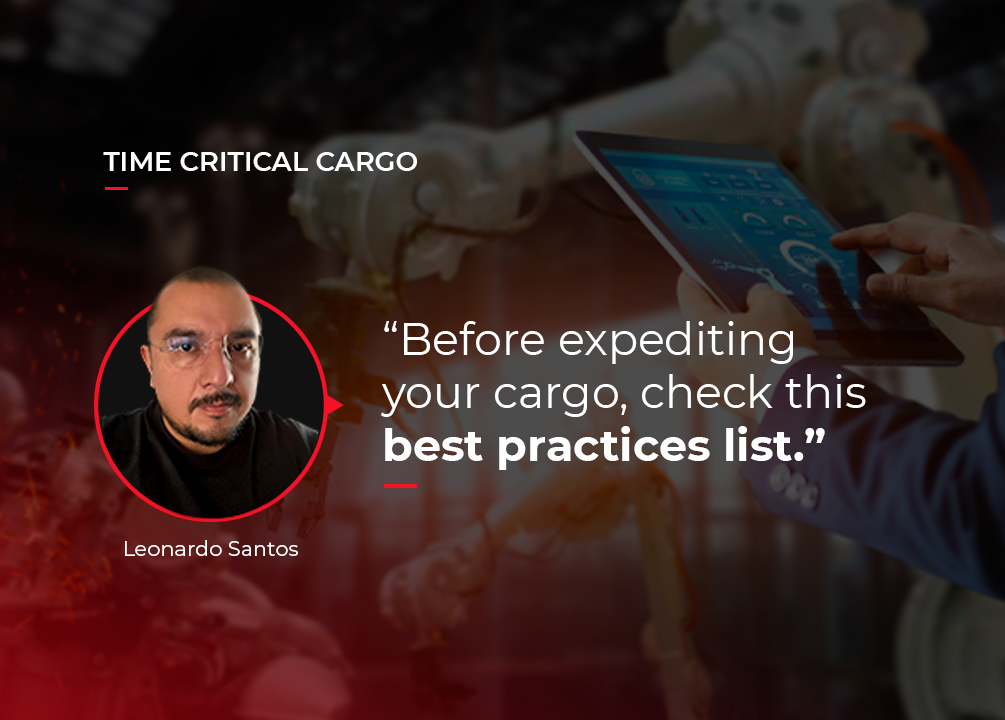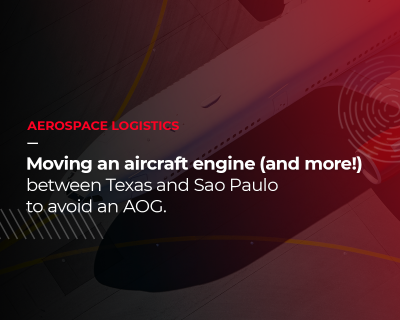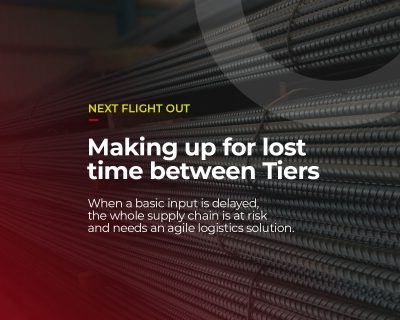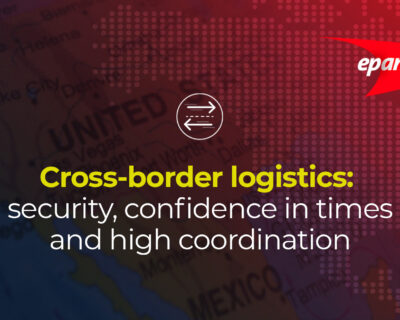
Posted on
27 July, 2021
in
Process industry: how to avoid that your cargo becomes critical
Working with a trusted logistics partner at your side, you avoid extraordinary costs and the pressure of expedited cargo.
For today’s insight, we can divide the logistics world in two hemispheres.
Here, the movement of cargo volumes, the optimization of inventories in distribution centers, security and last mile services are points that are strengthen day by day through coordination and creativity, seeking to save money based on volume.
Things get a bit complicated in this hemisphere due to the contracts and commitments that organize all the different suppliers and customers.
This business structure has generated philosophies such as just-in-time and just-in-sequence, where compliance with precise delivery times becomes essential for the correct operation of an assembly plant or the delivery of an existing project on time.
In this article, I will focus on logistics dedicated to companies in the process industry.

In fact, over the years, we have identified some specific challenges that these types of companies face and that lead them to think about requesting services for urgent movements:
Recommend reading: the complex interconnectivity of the supply chain in the automotive industry
However, this does not mean that at the first sign that a delivery date will not be met, the Traffic Manager must immediately decide to generate extraordinary costs by hiring an air charter worth thousands of dollars.
Whether you’re just getting to the industry or you’re already an old sea dog in logistics, you can benefit from the following tips and good practices you must review before deciding to expedite your cargo.
Many times, one can find a small stock in warehouses, just left behind. To avoid this type of waste, some companies have developed or adopted practices such as just-in-time or just-in-sequence.
Other warehouses adopt another good practice: saving a small, well-recorded reserve stock.
The truth is that we’ve seen how both practices can save costs, keeping lines running for a few hours.
It is equally important to review the inventory in transit – that is, if any material is already on its way. Depending on the transport mode and the cargo location, it is possible to speed up the transit times (see point 4 for more details).
Always keep and open communication channel with your suppliers, since there may be small stocks in the suppliers’ warehouses that can save the day.
Project managers can often maneuver production to save more time, enabling the arrival of the material that was in transit and avoiding the dispatch of a new batch.
Read our article on how lead time is a double-edged sword for logistics
On many occasions, first and last mile logistics can be accelerated for an international movement, with the possibility of shipping your cargo on a closer flight. In this case, for example, you’d only have to partially invest in a dedicated recollection, which can avoid excessive expenses in transport.
Read a success story where a HAZMAT cargo became critical midway through and the solution we found
In the case of ground transportation in North America, the change of modality is a real alternative.
For example, if your merchandise travels consolidated in an LTL unit, it will generally be making stops at different warehouses in the provider’s network until it reaches the destination point. On many occasions, it is possible to rescue it from those warehouses and dedicate a smaller and more agile unit (vans or sprinter vans) to speed up the shipment.
On the other hand, in air services, in times of great demand (the famous peak seasons), if the merchandise is already at the airport with an airline, it is still possible to raise the level of service to ensure being the first in line to go up the plane.
While there are situations where it is obvious that you have to request critical cargo solutions, most situations where you have more than 72 hours until the collapse of the production line should not be solved with an expedited shipment.
The trick is to have a fairly assertive communication, make your suppliers aware of the consequences and make the delivery deadline very clear, so that your freight forwarder and your customs agent are on the same page as you. With this, both will have the clarity that you need appropriate options for this specific situation.
Once you have synchronized the team, it is essential to be opened to listening to alternatives and to work as a team to resolve the situation, with everyone’s best effort to avoid reaching extreme situations.
A manager dedicated to your account (Key Account Manager – KAM) will identify opportunities, analyze results, and generate strategies to achieve perfect logistics operations. Click here to learn more about it from our senior KAM.

Time sensitive services enable the transformation industry to keep its production lines running and delivering on time, according to its strategic plans.
With the same mindset, we have strived to be the leaders in the North American market in Critical Cargo solutions, helping our clients to generate additional plans and an agile and effective solution to avoid disruptions in their supply chains.
I invite you to read some of our success stories, in which we’ve transformed urgent cargo into big business for our clients and to contact us to design together time-sensitive plans or learn about our solutions that you may have on hand in a logistical emergency.
Logistics on retail and processing industries
There are clear differences related to their objectives and logistical needs between them.Retail hemisphere
In the famous retail, the logistics mission is to bring their consumer product to the hands of the final consumer.Here, the movement of cargo volumes, the optimization of inventories in distribution centers, security and last mile services are points that are strengthen day by day through coordination and creativity, seeking to save money based on volume.
Process industry hemisphere
The other population comprehends logistics professionals who work for companies in the process industry and who, for the most part, are part of a larger production chain. Their main business model is business to business (B2B).Things get a bit complicated in this hemisphere due to the contracts and commitments that organize all the different suppliers and customers.
This business structure has generated philosophies such as just-in-time and just-in-sequence, where compliance with precise delivery times becomes essential for the correct operation of an assembly plant or the delivery of an existing project on time.
In this article, I will focus on logistics dedicated to companies in the process industry.

“Critical, or not critical? That is the question”
In logistics strategies dedicated to companies in the process industry, it is almost impossible to avoid critical situations.In fact, over the years, we have identified some specific challenges that these types of companies face and that lead them to think about requesting services for urgent movements:
- Production disruption due to poor quality materials.
- Forecast changes due to a sudden increase in demand.
- Continuous prototype development.
- Launch of new projects.
Recommend reading: the complex interconnectivity of the supply chain in the automotive industry
However, this does not mean that at the first sign that a delivery date will not be met, the Traffic Manager must immediately decide to generate extraordinary costs by hiring an air charter worth thousands of dollars.
Whether you’re just getting to the industry or you’re already an old sea dog in logistics, you can benefit from the following tips and good practices you must review before deciding to expedite your cargo.
- Are you sure you don’t have that part in stock?
Many times, one can find a small stock in warehouses, just left behind. To avoid this type of waste, some companies have developed or adopted practices such as just-in-time or just-in-sequence.
Other warehouses adopt another good practice: saving a small, well-recorded reserve stock.
The truth is that we’ve seen how both practices can save costs, keeping lines running for a few hours.
It is equally important to review the inventory in transit – that is, if any material is already on its way. Depending on the transport mode and the cargo location, it is possible to speed up the transit times (see point 4 for more details).
- Can the supplier send you more material?
Always keep and open communication channel with your suppliers, since there may be small stocks in the suppliers’ warehouses that can save the day.
- Negotiate, negotiate and negotiate a little more…
Project managers can often maneuver production to save more time, enabling the arrival of the material that was in transit and avoiding the dispatch of a new batch.
Read our article on how lead time is a double-edged sword for logistics
- Speed logistics
On many occasions, first and last mile logistics can be accelerated for an international movement, with the possibility of shipping your cargo on a closer flight. In this case, for example, you’d only have to partially invest in a dedicated recollection, which can avoid excessive expenses in transport.
Read a success story where a HAZMAT cargo became critical midway through and the solution we found
In the case of ground transportation in North America, the change of modality is a real alternative.
For example, if your merchandise travels consolidated in an LTL unit, it will generally be making stops at different warehouses in the provider’s network until it reaches the destination point. On many occasions, it is possible to rescue it from those warehouses and dedicate a smaller and more agile unit (vans or sprinter vans) to speed up the shipment.
On the other hand, in air services, in times of great demand (the famous peak seasons), if the merchandise is already at the airport with an airline, it is still possible to raise the level of service to ensure being the first in line to go up the plane.
- Explain the situation to your cargo agent
While there are situations where it is obvious that you have to request critical cargo solutions, most situations where you have more than 72 hours until the collapse of the production line should not be solved with an expedited shipment.
The trick is to have a fairly assertive communication, make your suppliers aware of the consequences and make the delivery deadline very clear, so that your freight forwarder and your customs agent are on the same page as you. With this, both will have the clarity that you need appropriate options for this specific situation.
Once you have synchronized the team, it is essential to be opened to listening to alternatives and to work as a team to resolve the situation, with everyone’s best effort to avoid reaching extreme situations.
A manager dedicated to your account (Key Account Manager – KAM) will identify opportunities, analyze results, and generate strategies to achieve perfect logistics operations. Click here to learn more about it from our senior KAM.
Europartners, by your side on programmed shipments and critical cargo, too
At Europartners Group, we have extensive experience developing solutions for what we call time sensitive logistics.
Time sensitive services enable the transformation industry to keep its production lines running and delivering on time, according to its strategic plans.
With the same mindset, we have strived to be the leaders in the North American market in Critical Cargo solutions, helping our clients to generate additional plans and an agile and effective solution to avoid disruptions in their supply chains.
I invite you to read some of our success stories, in which we’ve transformed urgent cargo into big business for our clients and to contact us to design together time-sensitive plans or learn about our solutions that you may have on hand in a logistical emergency.

Tags: Time Critical Cargo
Related posts
28 April, 2022
Aviation logistics: up and down to the last detail
To overcome an AOG situation, aviation logistics experts must act fast. Any detail missing can increase the [...]
Read more19 April, 2022
Aircraft engine logistics: a passion
To move aircraft engines between Texas (USA) and Sao Paulo (Brazil), you need a strategic partner in [...]
Read more22 October, 2021
Next flight out, one of the best ways to avoid a line stoppage
Leverage agile frameworks to provide a robust synopsis for high level overviews.
Read more21 June, 2021
Cross-border logistics: How to tackle challenges between USA-MEX-CAN?
Leverage agile frameworks to provide a robust synopsis for high level overviews.
Read more





